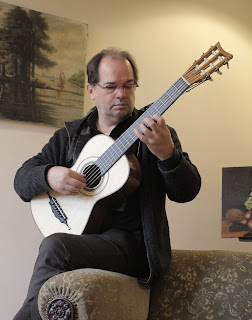Early 19th century Guitar - 1790 /1840 -
Herman enchants his audience with captivating performances on an exquisite 'Petitjean L'Ainé' guitar from the early 19th century, crafted in Mirecourt, France around 1820. Additionally, he delights listeners with the sweet melodies emanating from a beautiful replica of a Luis Panormo guitar, a Spanish-style masterpiece dating back to 1835. The Panormo family of Sicily was renowned for their exceptional replicas of Stradivarius violins and remarkable guitars. Luis Panormo himself operated a celebrated shop in the bustling city of London.
Driven by his passion for instrumental virtuosity, dynamic expression, and profound emotion, Herman has developed a personal technique that is truly captivating. His creative spirit thrives on exploring the vast richness of sound, uncovering new frontiers in sonic quality.
Fine art ukulele page. Machete & rajão page.
An enchanting Italian tale!
The earliest six-string guitar, consisting of a single string, emerged towards the end of the 18th century. In 1792, Moretti's seminal six-string guitar method surfaced in Italy. Around the same time, France also began producing six-stringed guitars, followed by Spain a few years later. These guitars featured gut strings and silver-wound silk basses, exerting significantly less tension compared to modern instruments. Over time, the guitar's evolution included pronounced curves, a larger body, and ornate rose coverings. The sound hole was even removed to enhance volume. The frets transformed from tied gut to fixed strips, initially crafted from ebony or ivory, eventually replaced with metal. Likewise, the wooden pegs were eventually substituted with metal tuning machines.
Unlike most contemporary classical guitarists, players of
romantic-era guitars often held the instrument using a strap around
their necks. There was also a divide among players regarding the use
of fingernails. Furthermore, the right-hand technique employed on
these guitars differed from the modern classical guitar, bearing a
resemblance to the plucking style of the lute.
While the modern guitar tends to emphasize bass tones at the expense of balance, the early 19th century guitar boasted exceptional equilibrium. This smaller-sized instrument produced a mellower, well-rounded tone that resonated with charm and elegance.
Noteworthy composers and players from the 19th century include the likes of Fernando Sor, Ferdinando Carulli, Matteo Carcassi, Mauro Giuliani, Francesco Molino, Luigi Legnani, and many others. Their contributions to the world of music continue to inspire and captivate audiences to this day.
Herman Vandecauter 0032 (0)479 646171 h.riachuelo@gmail.com
freevisitorcounters








Comments
Post a Comment